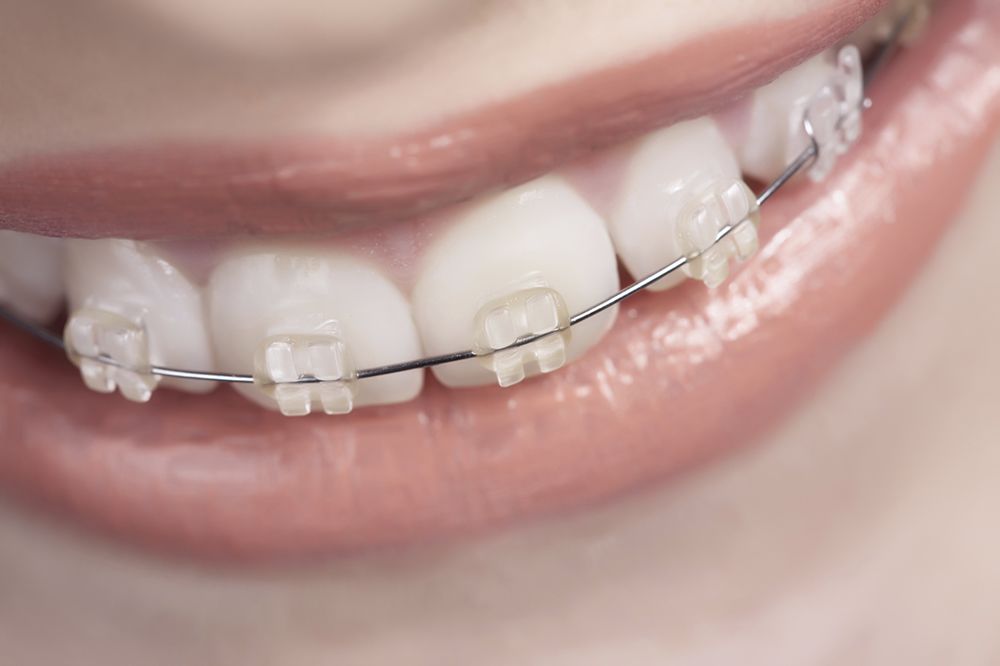Orthodontic Treatments
WHAT ARE BRACES?
Dental braces are devices used to align or straighten the teeth and guide the teeth to the desired position. Braces are made up of wires, brackets, and bands. They aid to correct misaligned teeth positioning, jaw correction, improvement in chewing, and smile aesthetics. Your dentist can instruct on treatment options and modalities depending upon dentition.
WHAT ARE BRACES USED FOR?
The most common reason is to improve facial appearance. What people are not aware of is that there are any other implications that require orthodontic treatment such as open bite, jaw structure, crossbite, etc.

WHAT IS ADULT DENTITION?
Adult Dentition is a stage where your adult teeth or permanent teeth replace primary teeth which helps in appearance, speech, and digestion. During this stage, people can face many issues which can be successfully revised by Braces. These issues can be summarized as below:
- Crowding / Haphazardly placed teeth can lead to bad oral hygiene and can also be the reason for cavities.
- Improper Bite that can affect chewing efficiency
- Crooked teeth that can be a major cause for Periodontal problems like Bleeding Gums, Halitosis (Bad Breath), and Tooth Mobility (Premature loss of teeth)
- If the teeth are misaligned, then it can be a reason for calculus deposits which leads to yellow teeth
- Forwardly placed / Proclined Teeth that can lead to more convex profile and posteriorly displaced chin
- Open Bite
- The spacing between teeth can be a reason for speech problems.
WHAT IS MIXED DENTITION?
In this stage, one has a combination of both primary and permanent teeth. Using braces in Mixed Dentition can cure the below-mentioned problems:
- Jaw Growth disorders at Mixed Dentition can be adjusted in a non-invasive manner which may require surgical correction in late stages.
- Treatment of crooked teeth. This requires to be taken care of during an early stage. Otherwise, it will affect Child’s psychology later.
WHAT IS THE RIGHT TIME TO GET BRACES?
Each and every one of us is unique. Orthodontic treatment can be started from the early stage ranging from 7 years old. However, there are no upper age limit Braces.
If you can maintain good oral health and firm teeth, braces can be used at any age.
various Orthodontic treatments are available for all ages.
WHAT TYPES OF BRACES ARE AVAILABLE?
Metal Conventional Braces:
This is a traditional and commonly used type of braces. The metal braces used in the present are comparatively more comfortable and smaller in size. These braces will need elastics which come in several colors to tie the wire to the braces. The wires will utilize your body heat to force and move teeth more quickly to the required position. The pain is less. There is no specific age limit to these braces, as anyone in any age can choose to straighten their teeth using metal braces.
Metal Self Ligating Braces
Metal Self-Ligating Braces come with a shutter or lock system. These braces do not need to use elastic to tie the wire. When compare with metal braces, self-ligating braces are more comfortable and smaller in size. Metal Self Ligating Braces are helpful in achieving arch expansion and thus minimize the need for extraction.
Ceramic Conventional Braces
This type of braces is the one that comes with clear brackets. They use the color of the tooth color and blend in more naturally with your teeth. The shape and size do not vary when compared with metal braces. Ceramic Conventional Braces are less visible and as a result, are preferred by older teenagers and adults who might have aesthetic concerns. Sometimes, even the wires used for these braces are of similar to tooth color which makes them even less noticeable. Although, they require extra care and protection compared to metal braces as they are larger and more fragile. Hence Ceramic Conventional Braces are widely used in upper teeth than lower.
Lingual Braces
Lingual Braces are heavy metal braces that are positioned behind the teeth. These metallic braces can be made using even silver or gold if you want. The individual Bracket is customized using 3D Designing. Lingual Braces are highly aesthetic and less visible. However, these types of Braces can cause mild speech difficulties during the course of the treatment.
Aligners
Clear Aligners are medical-grade plastic trays that do not need the support of any braces or wire. Aligners are completely invisible. Hence, if you are someone with high aesthetic concerns, Aligners can be a very appealing orthodontic treatment. Aligners are placed inside, but there is no restriction when it comes to food. Also, they do not cause any speech difficulty. Besides, transparent braces are highly comfortable and hygienic. Clear Aligners has the ability to hide existing gaps as well.
POST-TREATMENT CARE FOR BRACES
- Make it a habit of Brushing & Flossing twice a day to have good oral health. Healthy teeth are responding well to the treatment.
- Visit your dentist duly for follow-up checks. Put a reminder of your appointments and follow suggestions, if there is any.
- Patience is the key. The time period of the treatment may vary depending on your case. Remember that the teeth will require some time to adjust accordingly.
DO’S AND DON’TS WITH BRACES ON
DO’S
- Refrain from sticky food like gum or caramel
- If you do sports, wear a mouthguard
- Go for the low sugar drinks and avoid carbonated beverages.
- Brush after having a meal and never let food stuck on your braces
- Visit your dentist on time.
DON’TS
- Avoid chewing hard food and ice
- Refrain from nail-biting.
- Avoid having soda more than once a week
- Floss like a boss.
